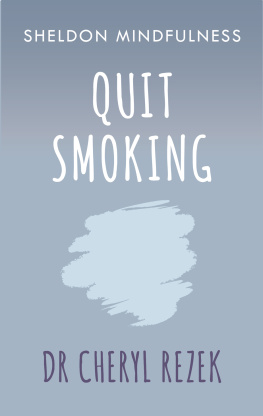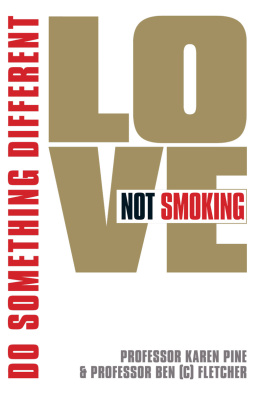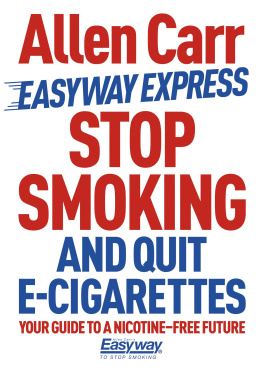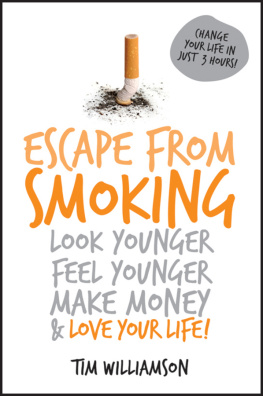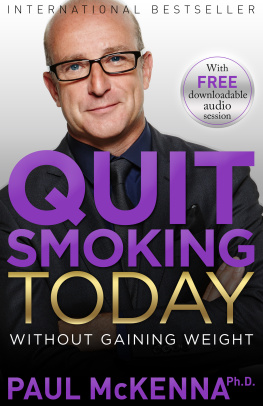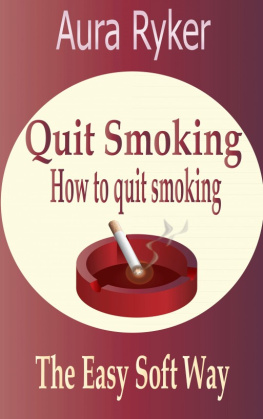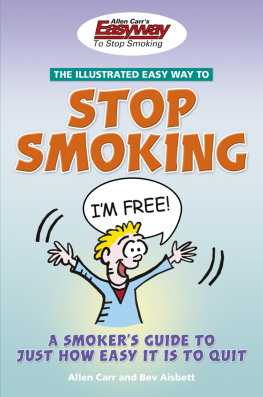
D isclaimer - Page 3
Introduction - Page 3
The Massive Problem! - Page 7
Why Do You Want to Quit Smoking? - Page 7
Why smoke in the first place? - Page 10
Some Facts You Should Note - Page 17
Danger of smoking - page 22
The grim statistics of Smoking - Page 27
The effect of second hand smoke - Page 28
Why Has Smoking Got a Stranglehold on you - page 29
Are You ready to quit smoking - page 32
Why you Should Quit Right Now - Page 36
Smoking and Impotence - Page 41
What happens every time you take a puff - Page 43
The cost of smoking - Page 45
The habit - Not just addiction - Page 46
Stop Smoking Aids - Page 47
The problem with vaping - Page 57
Tips to help you achieve your goal - Page 64
The day that changes your life - page 65
Deciding on a Quitting Program - Page 67
Mind the company you keep - page 79
Social Drinking and Smoking - page 80
Failing and Starting Again - Page 82
The Importance of a Support System - Page 84
Quitting Cold Turkey - Page 88
The problem with vaping - page 89
The problem with Big Pharma - page 94
The giving up and gaining wait myth - page 98
If they jumped off a bridge, would you? - Page 101
Do it because we love you - page 104
Learning from failing - page 106
Science and FDA approval - page 107
Successful Quitters - page 109
The best reasons to stop - page 111
Famous quotes for motivation - page 113
The magic ingredients you need to stop smoking - page 114
The secrets no one told you! - Page 123
4 ways turmeric protects you from the damaging effects of smoking - page 125
The magic ingredient of Curcumin - Page 127
Help For cravings and tough situations - page 132
When you get the crazies - page 135
Other ways to Stay active - page 135
Staying tobacco free over the holidays - page 137
Build you quit smoking plan - Page 138
The secret method that made Robert quit smoking - page 139
Conclusion - Page 142
References - Page 144
Additional Resources to help your journey - page 145
A ll the material contained in this book is provided for educational and informational purposes only.
No responsibility can be taken for any results or outcomes resulting from the use of this material.
While every attempt has been made to provide information that is both accurate and effective, the author does not assume any responsibility for the accuracy or use/misuse of this information.
M y names Aisha Murphy and firstly I wanted to thank you for purchasing this eBook and taking a positive step towards quitting smoking.
In the last twenty or so years, smoking has lost the popularity that it once held for many people in nearly every demographic in the world.
Before this time, it seemed as though everyone would light up just about anywhere. You would go into a hospital emergency room and see the doctors and nurses having a cigarette in the lobby with injured and sick patients who were
smoking cigarettes as well.
Back in the 1950s, smoking was fashionable. In fact, it was considered commonplace. Back then, you could smoke everywhere in restaurants, airplanes, grocery stores, even hospitals.
A smoker never got a dirty look for lighting up in public. It was the people who DIDNT smoke who were in the minority.
My, how times have changed!
Smoking is nothing new to civilization. In fact, scientists can determine that as far back as 1000 B.C.
People start using the leaves of the tobacco plant for smoking and chewing.
How and why tobacco was first used in the Americas no one knows. The first users are thought to have been the Mayan civilizations of Central America. Its use was gradually adopted throughout the nations of Central and most of North and South America.
From that moment, tobacco production began catching on and tobacco products became readily available throughout the young United States of America. In 1832, the first paper cigarette was introduced.
It is widely believed that the first paper rolled cigarettes were made by Egyptian soldiers fighting the Turkish-Egyptian war. Other historians suggest that Russians and Turks learned about cigarettes from the French, who in turn may have learned about smoking from the Spanish.
It is thought that paupers in Seville were making a form of cigarette, known as a 'papalette', from the butts of discarded cigars and papers as early as the 17th century.
In 1900, Smoking jackets and hats have been introduced for gentleman smokers. After-dinner cigar (with a glass of port or brandy) is now an established tradition in turn of the century Britain. Cigarettes are also a part of life.
In 1950, evidence of a link between lung cancer and smoking is published in the British Medical Journal. Research was done by Professor (now Sir) Richard Doll and A Bradford Hill. In 1964, the United States Surgeon General tells Americans that smoking causes lung cancer. Not many people listened.
Shortly after, in 1965, federal law not only prohibits tobacco advertising on television, but they also make it mandatory to include the Surgeon Generals warning in print on all cigarette packs. The last radio ads for cigarettes ran in 1971.
The airline industry began making concessions for the anti-tobacco coalition. In 1975, they created separate smoking sections on airplanes causing disturbances with customer everywhere.
Next page

